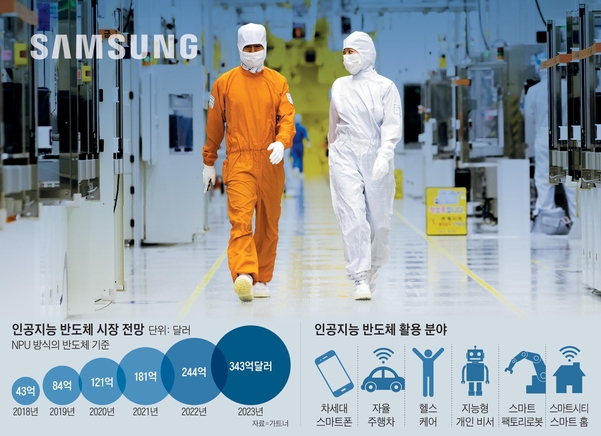Enter 2021.01.12 12:00
Core chips to move next-generation smartphones and self-driving cars… Target 20% share in 2030
The government is investing 125.3 billion won this year to nurture the artificial intelligence semiconductor (NPU/Neural Processing Unit), which is still in its infancy, into a’second DRAM’. Through this, it is calculated to occupy 20% of the global market share in the artificial intelligence semiconductor market by 2030.
Artificial intelligence semiconductor refers to a high-performance, low-power system semiconductor specialized in implementing artificial intelligence such as learning and reasoning. It is expected to create a new market by converging with various industrial fields such as mobile, automobile, and home appliances.
Market research firm Gartner predicts that the artificial intelligence semiconductor market, which was worth 12.1 billion dollars (about 13 trillion won) last year, will nearly triple to 34.3 billion dollars (about 38 trillion won) in 2023.

Minister of Science and Technology Choi Ki-young said, “Last year, if we laid the foundation for the artificial intelligence semiconductor industry through the establishment of mid-to-long-term development strategies and core technology R&D (research and development) planning and launch, this year, large R&D, fostering innovative companies, and nurturing human resources. “We will carry out policies such as creating an initial market in connection with the project and the digital new deal,” he emphasized.
Minister Choi also said, “Through this, we will make Korea a leading country in the field of artificial intelligence semiconductors as well as memory semiconductors, thereby realizing a comprehensive semiconductor powerhouse in 2030.”
◇ 86.5% of the budget is concentrated on core technology development
This year, the government will support 13 projects in three major areas: △Development of core technologies (1084 billion won), △ Foster innovative companies (7.7 billion won), and △Industrial foundation construction (9.2 billion won).
Most of the budget is expected to focus on developing core technologies. 1084 billion won, or 86.5% of the total, was allocated.
The government is planning to support full periodic R&D such as development of source technology necessary for each stage of growth of artificial intelligence semiconductor companies → development of commercial application technology → demonstration.
First of all, with regard to securing artificial intelligence semiconductor technology that has invested KRW 1 trillion for 10 years, starting from last year, it plans to continuously support innovation in design, device, and process technology, and new support for 19 tasks, including the development of new device technology for brain neurons.
In addition, the R&D project to preempt the new concept of PIM (Processing In Memory) semiconductor technology that integrates storage (memory) and computation (processor) functions using the world’s No. 1 memory semiconductor capability will be carried out step by step.
Support for industry-academia-research cooperation application technology development, such as technology transfer and manpower support for R&D original technologies owned by research institutes and universities, will also be expanded so that semiconductor companies can commercialize their products early. Support projects such as upgrading system SW (compiler, library, etc.) and development of design tools to strengthen the capabilities of the software (SW) field, which are evaluated as vulnerable by domestic companies, will also be promoted.
A demonstration project that supports the creation of initial market demand by piloting domestically developed artificial intelligence semiconductor technologies and products to public and private data centers and digital new deal projects is also being promoted.
In order to foster innovative companies that will lead the artificial intelligence semiconductor market, 8 start-ups, small and medium-sized venture fabless (semiconductor design companies) companies are selected to convert microprocesses, develop and utilize new design assets (IP), and optimize software. A business is also underway to resolve technical difficulties through support.
In the long term, in order to cultivate advanced manpower such as artificial intelligence semiconductor design manpower, three additional centers for training artificial intelligence and system semiconductor research manpower will be installed in the university to cultivate advanced masters and doctoral-level talents capable of developing original technology. It is also promoting the establishment of’Artificial Intelligence Semiconductor Related Courses’ at the Graduate School of Artificial Intelligence and attracting top-notch talents such as Ph.
◇ “Developing 4 artificial intelligence semiconductors, aiming to cultivate 270 professionals”
Through this, the government expected to create more visible results this year, such as the additional development of four artificial intelligence semiconductors, support and demonstration of commercialization of two cases, and training of 270 experts.
The Ministry of Science and ICT will continue to communicate and collaborate with the’Next Generation Intelligent Semiconductor Project Group’, which was launched last year, and the’Artificial Intelligence Semiconductor Forum’ composed of experts from industry, academia, and research institutes, so that the large-scale projects being promoted can be systematically managed and achieved. to be.
In addition, the plan is to enhance solidarity and cooperation between design companies, foundry (consigned semiconductor production) and demand companies, centering on artificial intelligence semiconductors, and continue to discover and support policy tasks necessary for the development of the technological and industrial ecosystem.
